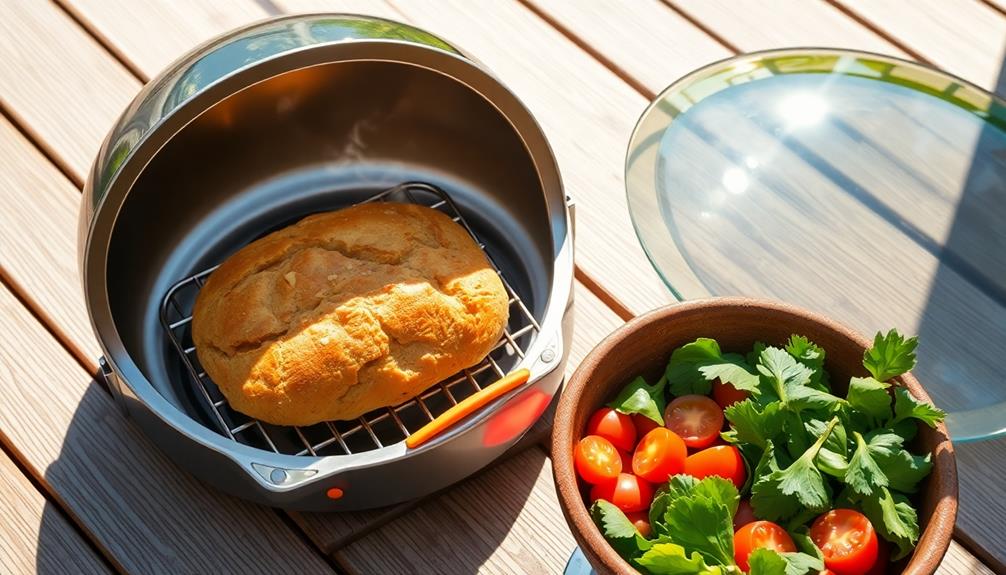Cooking with clay pots, like the iconic tagine and versatile Roman pottery, is an exciting way to unlock rich flavors and honor ancient traditions. You'll be amazed at how the porous clay regulates temperature, retains moisture, and infuses your dishes with robust, earthy notes. Soak the pots first to prevent cracking, then layer in your ingredients, cover, and let the magic happen. Whether you're preparing stews, soups, or roasted meats and veggies, clay cookware brings a unique culinary experience. Get ready to explore the wonders of cooking in clay – the journey has only just begun.
Key Takeaways
- Clay cookware has a rich cultural history, with techniques evolving alongside civilizations and inspiring modern chefs to appreciate traditional cooking methods.
- Cooking in clay vessels offers benefits like slow, even heating, moisture retention, and enhanced flavors and textures compared to conventional methods.
- Common types of clay cookware include tagines, Roman pottery, earthenware, stoneware, and terracotta, each with unique properties and applications.
- Proper preparation, such as soaking and seasoning, and slow cooking techniques are essential for unlocking the full potential of clay cookware.
- Clay cooking is versatile, suitable for preparing a wide range of dishes, from stews and roasts to baked goods, while also contributing to unique culinary experiences.
History
The ancient art of cooking in clay vessels has endured throughout the centuries, captivating the culinary imaginations of cultures worldwide. From the iconic Moroccan tagine to the rustic Roman pottery, these earthen wares have played a pivotal role in the evolution of global cuisine.
In ancient times, clay pots and dishes weren't just for cooking – they were a reflection of a community's traditions and values. The Egyptians, for instance, used clay to create intricate vessels for storing and serving food, while the Greeks and Romans incorporated clay into their daily lives, crafting everything from simple bowls to elaborate platters. In many cultures, clay pot cooking benefits were well-known, as the porous nature of clay allowed for even and gentle heat distribution, resulting in tender and flavorful dishes. Additionally, the use of clay pots for cooking has been linked to health benefits, as they do not leach harmful chemicals into food and are an eco-friendly choice. Overall, the significance of clay pots and dishes in ancient societies goes far beyond their practical function, and they continue to hold cultural and culinary importance today.
As civilizations rose and fell, the techniques for working with clay evolved, with each culture leaving its unique mark on the art of cooking in clay.
Today, this ancient practice continues to inspire chefs and home cooks alike, who appreciate the unique flavors and textures that clay vessels can impart to their dishes.
Recipe
Cooking food in clay pots or vessels has been a traditional method for centuries, allowing for slow, even heating and the retention of moisture and flavors. The unique properties of clay not only enhance the cooking process but also create a distinct taste that can elevate dishes. This butter enhances flavor technique showcases the benefits of this ancient cooking method.
Clay pots can be used to create a wide range of dishes, from hearty stews to delicate baked goods. The porous nature of the clay helps to regulate temperature, ensuring that the food cooks evenly and retains its natural juices and essences.
Ingredients:
- 2 lbs boneless chicken thighs, cut into 1-inch pieces
- 1 onion, diced
- 3 cloves garlic, minced
- 2 carrots, peeled and sliced
- 1 cup diced potatoes
- 1 cup chicken broth
- 1 tsp dried thyme
- Salt and pepper to taste
Instructions: Place the chicken, onion, garlic, carrots, and potatoes in a clay pot. Pour the chicken broth over the ingredients and sprinkle with the dried thyme. Season with salt and pepper. Cover the pot with a tight-fitting lid and place it in a preheated oven at 325°F. Cook for approximately 1.5 to 2 hours, or until the chicken is cooked through and the vegetables are tender.
When cooking with clay pots, it's important to soak the pot in water for at least 30 minutes before use to ensure even heating and to prevent the pot from cracking. Additionally, clay pots should be handled with care, as they're delicate and can break if dropped or subjected to sudden temperature changes.
Cooking Steps
Start by soaking your clay pot in water overnight.
Once it's prepped, add your favorite seasonings and pop it onto the stove at medium heat.
Cover it with a lid and let it cook for a full 60 minutes – your dish will be bursting with flavor!
Step 1. Soak Pottery in Water Overnight

Before you can begin cooking in your clay vessel, you'll need to soak it in water overnight. This simple step helps prepare the pot for use. As the clay absorbs the water, it becomes more porous and ready to evenly distribute heat during the cooking process.
Start by fully submerging the pottery in a large bowl or container filled with cool water. Let it sit for at least 8 hours, or overnight. This allows the clay to become thoroughly saturated. The water will help the vessel heat up quickly and cook your food evenly.
After soaking, carefully remove the pot from the water. Gently pat it dry with a clean cloth. Your clay cookware is now ready to use!
Whether you're making a delicious tagine or roasting vegetables, the pre-soaked pot will perform beautifully. Get ready to enjoy the flavorful results of cooking in clay.
Step 2. Add Seasonings
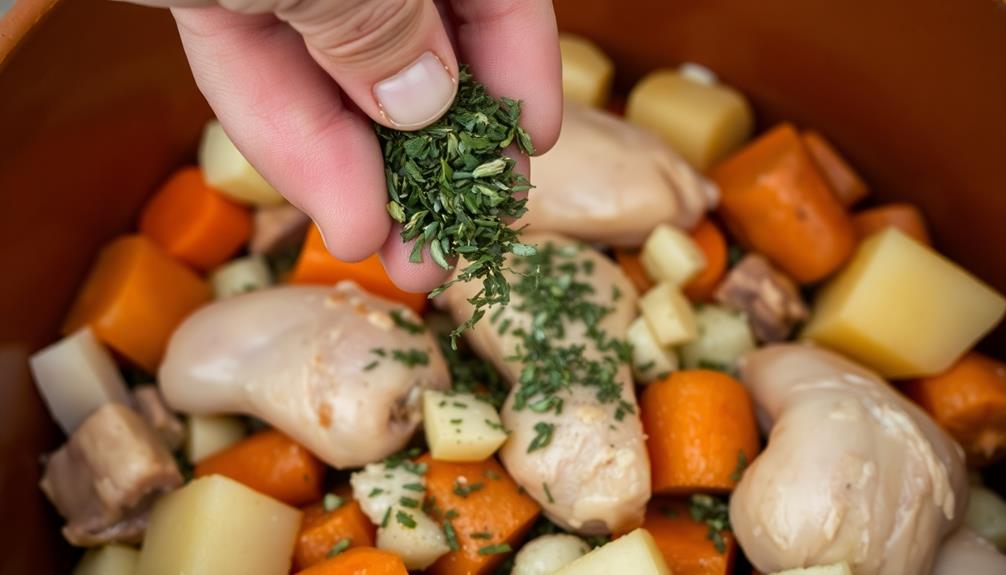
Your clay cookware's next important step involves adding seasonings. Once your pottery has soaked overnight, it's time to bring out those bold flavors!
You'll want to carefully select a variety of dried herbs, spices, and even citrus zests to create a flavor profile that complements your dish. Incorporating essential oils can also enhance the aromatic experience of your meal, as they provide natural antibacterial properties and can improve indoor air quality essential oils for cleaning.
Rub the seasonings directly onto the interior of the clay pot, making sure to get them into all the nooks and crannies. Don't be shy – a generous coating will infuse your food with irresistible aromas and tastes.
Consider using garlic, rosemary, thyme, paprika, or cumin for a classic Mediterranean flair. For a twist, try ginger, turmeric, or curry powder. The key is to experiment and find the blend that excites your taste buds.
Once the seasonings are applied, you're ready to add your ingredients and begin the slow, gentle cooking process that clay cookware is famous for.
Get ready for a meal that's bursting with flavor in every bite!
Step 3. Cook at Medium Heat
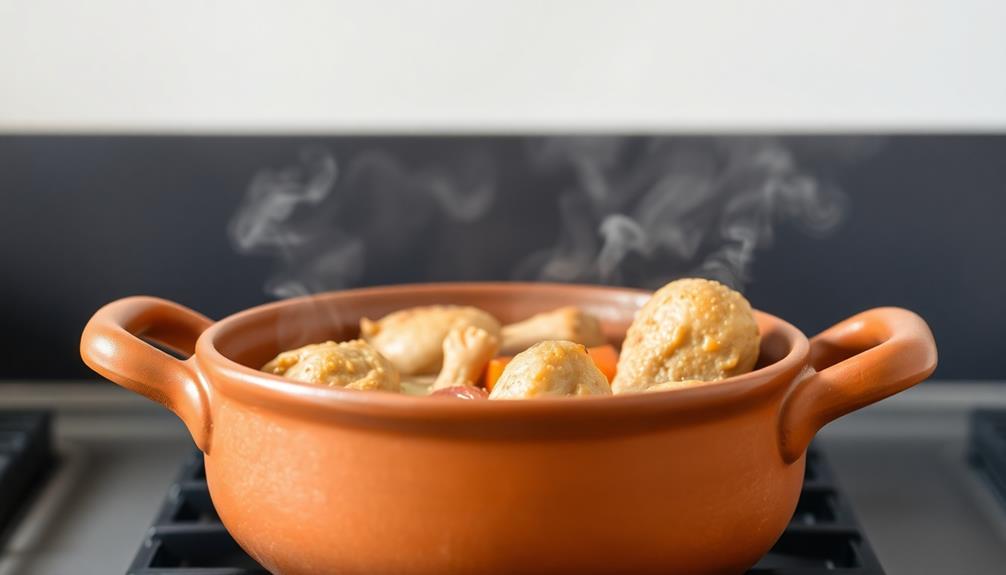
Once you've added the seasonings, crank up the heat to medium on your stovetop or oven. This is the perfect temperature for cooking your dish to perfection.
The medium heat will gently simmer your ingredients, allowing the flavors to meld together beautifully.
As the pot or pan heats up, you'll start to see the first signs of sizzling and bubbling. This is exactly what you want!
Keep a close eye on the dish, stirring occasionally to prevent anything from sticking or burning. The medium heat will ensure your food cooks evenly, with the outside developing a nice, golden-brown crust while the inside remains tender and juicy.
Step 4. Cover With Lid
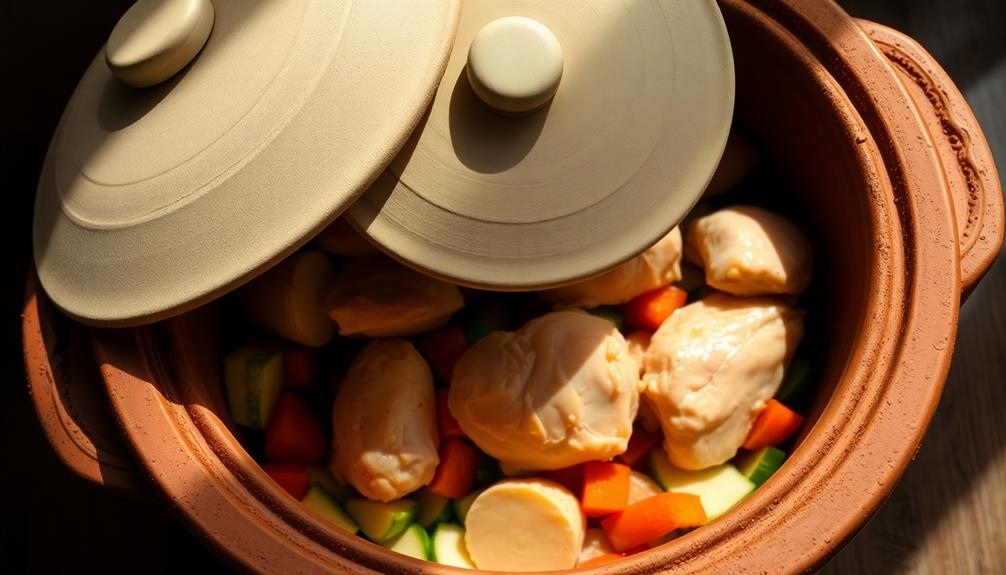
Why not cover the pot or pan with a lid at this point? It's a great idea! Covering the dish helps trap heat and steam inside, which speeds up the cooking process.
The lid also prevents moisture from escaping, keeping your food moist and juicy. Plus, it helps to evenly distribute the heat, ensuring your dish cooks thoroughly.
When you cover the pot or pan, you'll notice the temperature stays nice and steady. This allows the flavors to meld together beautifully. The steam builds up under the lid, gently cooking the ingredients.
Whether you're simmering a stew or steaming veggies, the lid is a handy tool. Just be careful when you remove it, as that hot steam can really escape quickly!
Give it a try – the difference in cooking time and results is impressive. Covering the dish is an easy way to take your clay pot cooking to the next level.
Step 5. Cook for 60 Minutes
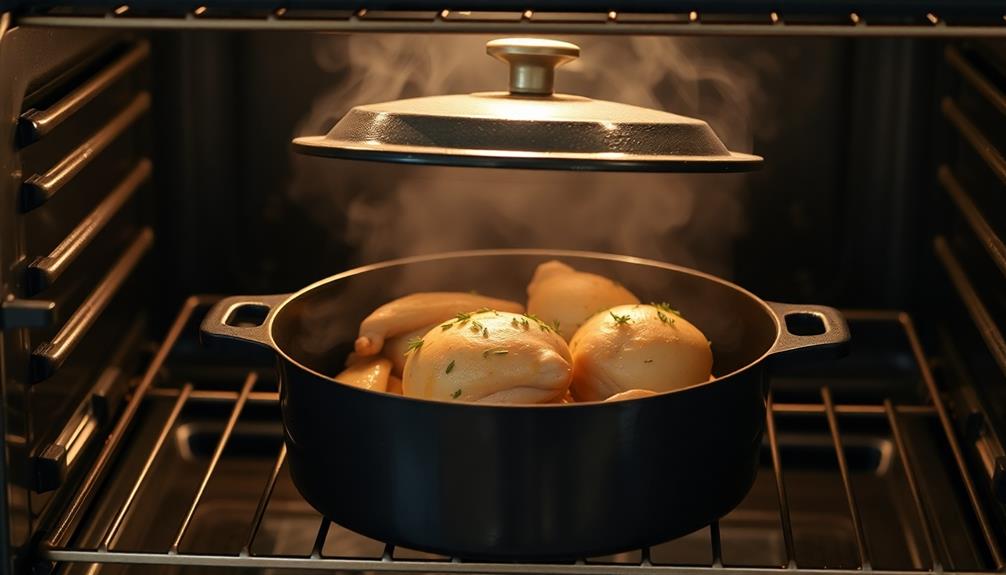
After covering the pot or pan with a lid, let the dish cook for about 60 minutes. This slow, steady cooking allows the flavors to meld and the ingredients to become tender.
The clay vessel's excellent heat retention ensures the dish maintains a consistent temperature, gently simmering and infusing the food with rich, earthy flavors.
As the aroma fills the kitchen, resist the urge to peek. Lifting the lid disrupts the cooking process and allows heat to escape, so keep it sealed tight.
The dish will be ready when the timer goes off. Use oven mitts to carefully remove the lid, as steam will rush out. Inspect the contents – the meat should be fork-tender, and the vegetables soft and infused with the cooking liquid.
If it needs a bit more time, simply cover and return to the oven for 10-15 minutes. Once fully cooked, let the dish rest for 5 minutes before serving. This allows the flavors to settle and the textures to firm up.
Enjoy your delicious clay-cooked creation!
Final Thoughts
Cooking in clay pots offers a unique and rewarding culinary experience. The distinct flavors and textures you can achieve are truly unparalleled. Whether you're preparing a savory tagine or experimenting with ancient Roman cooking techniques, the possibilities are endless.
As you've learned, clay pots require a bit more time and attention than conventional cookware, but the payoff is well worth it. The slow, even heat distribution ensures your dishes are cooked to perfection, infusing them with robust, earthy notes.
Plus, the inherent moisture-locking properties of clay help retain the natural juices and aromas of your ingredients.
Embracing the art of cooking in clay can open up a whole new world of flavors and culinary exploration. With a little practice, you'll be whipping up mouthwatering meals that will impress your family and friends.
Frequently Asked Questions
How Do I Clean and Maintain Clay Cookware?
To clean clay cookware, hand-wash it with warm, soapy water. Avoid harsh detergents that can strip the seasoning. Dry it thoroughly, then rub a thin layer of oil over the surface to maintain the seasoning. Store it in a dry place.
Can I Use Clay Cookware on an Induction Cooktop?
Using clay cookware on an induction cooktop isn't recommended. Clay's thermal properties don't work well with the electromagnetic technology of induction. You're better off using cookware designed for induction, like cast iron or stainless steel, to get the best results on your cooktop.
Are There Any Safety Considerations With Clay Cookware?
You should consider a few safety precautions when using clay cookware. Clay can crack or shatter if exposed to sudden temperature changes, so avoid placing hot pottery on cold surfaces. Also, ensure the clay is lead-free to prevent toxicity.
How Do I Season and Prepare a New Clay Pot?
To season and prepare a new clay pot, you'll need to soak it in water for a few hours, then dry it thoroughly. Next, rub the interior with a thin layer of oil before its first use. This helps condition the clay.
Can I Use Clay Cookware in the Oven?
Yes, you can use clay cookware in the oven. Just make sure to preheat the oven and the pot to prevent cracking. Clay cookware is oven-safe up to 400°F, so it's great for baking, roasting, and even making casseroles.


